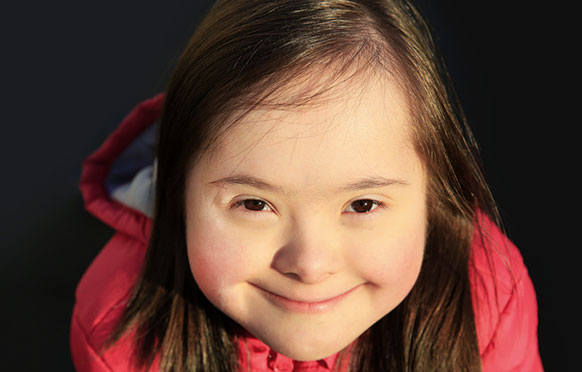
Fact Sheet FS1284
What Is a Developmental Disability?
Developmental disabilities are a group of conditions due to impairment in physical, learning, language, or behavior areas. Developmental disabilities substantially limit the individual in one or more major life activities related to self-care; understanding and expressive language; learning; self-direction and motivation; capacity for independent living; and economic self-sufficiency. Major life activities include walking, seeing, hearing, sitting, standing, lifting, working, and performing manual tasks.
According to the World Health Organization, disability is an umbrella term, covering impairments, activity limitations, and participation restrictions. Impairment is a problem in body function or structure. An activity limitation is a difficulty encountered by an individual in performing a task or action. A participation restriction is a problem experienced by an individual that restricts involvement in life situations.
Disability is not just a health problem. It is a complex phenomenon, reflecting the interaction between features of a person's body and features of the environment in which he or she lives. Overcoming the difficulties faced by people with disabilities requires interventions to remove environmental and social barriers.
More than six million individuals in the United States have developmental disabilities. About one in six children between the ages of 3 and 17 in the U.S. has one or more developmental disabilities or developmental delays. Children are diagnosed as having developmental delays when they do not reach their developmental milestones (functional skills or age-specific tasks that most children can do at a certain age range) at the expected times. Delays can occur in one or many areas including gross or fine motor, language, social, or thinking skills. A developmental disability occurs before the age of 22 and usually lasts throughout a person's lifetime.
Developmental Disabilities
Developmental disabilities include but are not limited to:
- Learning Disability (LD)
- Attention Deficit Disorder (ADD) and Attention Deficit Hyperactivity Disorder (ADHD)
- Autism Spectrum Disorder (ASD)
- Asperger's Syndrome (no longer a separate diagnosis; falls under ASD)
- Intellectual Disability (ID)
- Sensory Processing Disorder (SPD)
- Tourette Syndrome (TS)
Other disabilities outside the scope of this fact sheet include motor impairments, hearing impairments, visual impairments, and/or brain injury. Designing programs that include and are appropriate for participants with developmental disabilities requires a basic understanding of the characteristics of the disabilities. An inclusive environment is one that creates a sense of belonging and encourages and supports all of the participants.
Learning Disabilities
Learning disabilities are neurological disorders that affect the brain's ability to store, process, and communicate information. Individuals with a learning disability may have problems with:
- listening, speaking, reading, writing, spelling, or math
- letter or number reversals (dyslexia, dyscalculia)
- sequencing thoughts, events, and activities
- fine and gross motor skills
Attention Deficit Disorder and Attention Deficit Hyperactivity Disorder
Attention Deficit Disorder, also known as ADD, is a neurological disorder characterized by distractibility, forgetfulness, inability to concentrate, poor attention span, and impulsiveness.
Attention Deficit Hyperactivity Disorder, also known as ADHD, has the same characteristics as ADD but also includes hyperactivity. Hyperactivity is a condition in which a person has excess levels of energy or is unable to control his or her actions. This disorder makes it hard for the individual to pay attention.
ADHD is most commonly diagnosed by age 7 in boys and age 11 in girls but the average age of diagnosis is getting younger as information about ADHD improves. It is more widely recognized today because more demands are being placed on children so deficiencies in behavioral self-control are more apparent. The prevalence has probably always been the same since it is considered a genetic disease.
There is no "cure" for ADHD. Some of the difficulties experienced by children with ADHD ease somewhat as the brain matures, but to some degree, the disorder will remain throughout the individual's adult life. Because symptoms can change over time, the presentation or behaviors may change over time as well. Some typical behaviors are daydreaming; impulsivity; overactivity; distractibility; disorganization; carelessness; forgetfulness; talking too much; interrupting others; and/or taking unnecessary risks. Individuals with ADHD can have trouble paying attention; difficulty getting along with others; and/or trouble taking turns.
The Centers for Disease Control and Prevention (CDC) has identified three types of ADHD depending on which symptoms are strongest in the individual.
- Predominantly Inattentive - Individuals will have difficulties organizing or finishing a task; paying attention to details; following instructions or conversations; are easily distracted; may forget details of daily routines.
- Predominantly Hyperactive-Impulsive - Individuals may fidget; talk a lot; find it hard to sit still for long periods of time; exhibit restlessness; be impulsive. Younger children may run, jump, or climb constantly. A person with impulsiveness may be more prone to accidents and injuries than others. It is important to be aware of the person's safety at all times.
- Combined Presentation - The characteristics found in predominantly inattentive and predominantly hyperactive-impulsive are equally apparent.
Autism Spectrum Disorder
Autism Spectrum Disorder, also known as ASD, is a group of developmental disabilities that can cause significant social, communication, behavioral, and learning challenges. ASD is often referred to as an umbrella term that includes Asperger's Syndrome, Pervasive Developmental Disorder-Not Otherwise Specified, and Rett Syndrome. Symptoms range from very mild to severe. Almost half of those diagnosed with ASD have average to above average intellectual ability. About a third also have an intellectual disability.
More people than ever before are being diagnosed with Autism Spectrum Disorder. It is uncertain how much or whether this increase is due to a broader definition of ASD or to more effective diagnoses. However, a true increase in the number of people with ASD cannot be ruled out.
The cause of autism is not yet known. Genetic, biological, familial, and environmental risk factors are being studied. The Centers for Disease Control and Prevention reported in 2016 that 1 in 68 children in the United States have been diagnosed with ASD. The prevalence of ASD is higher in boys than girls (1 in 42 boys and 1 in 89 girls). In New Jersey the prevalence is 1 in 45 children.
Depending upon where an individual falls on the spectrum, from low to high functioning, the characteristics of ASD will be exhibited in varying degrees. ASD presents differently in each individual. It is often said that when you have met ONE person with autism, you have met ONE person with autism. Every individual is unique in how they exhibit the typical characteristics and behaviors.
Individuals with ASD may have trouble understanding other people's feelings or talking about their own feelings; maintaining eye contact; are often bothered by touch; may have rigid routines and restricted patterns of interest; and may exhibit repetitive behaviors and motor mannerisms such as hand flapping or rocking. They may also have sensory processing difficulties such as unusual reactions to smells, tastes, feels, or sounds. Individuals with ASD may need direction regarding how to honor people's personal space. Speech patterns may be atypical, such as speaking in a monotone voice.
Asperger's Syndrome
Asperger's Syndrome is one of the conditions that falls within Autism Spectrum Disorder. It is a pervasive developmental disorder in which the individual often has above average intellectual ability, but may experience ongoing difficulties with social interaction, empathy, logic, and understanding non-verbal cues. Asperger's is considered to be the mildest form of ASD and is synonymous with high-functioning autism. It is common for individuals with Asperger's to have fixated, narrow interests, repetitive behaviors, and motor clumsiness. Their speech may lack rhythm, have an odd inflection or a monotone pitch, and voice volume may not always be appropriate for the surroundings.
Intellectual Disability
Intellectual disability, also known as ID, is a term used when a person has an IQ low enough to create certain limitations in mental functioning, learning, and skills such as communicating, self-care, and social skills. Intellectual Disability can be mild, moderate, severe, or profound. Individuals with ID have limitations in social adjustment, communication, maturation, and acquisition of life skills. These limitations will cause a child or adult to learn and develop more slowly than a typical individual. Down Syndrome is one of several types of intellectual disability. Others are Fragile X, Fetal Alcohol Syndrome Disorder, and Acquired or Traumatic Brain Injury.
Sensory Processing Disorder
Sensory Processing Disorder, also known as SPD, is a neurobiological condition in which the brain has trouble receiving and responding to information that comes in through the senses (touch, smell, taste, sound, sight). People with SPD have difficulty focusing, participating, and learning because of the functional limitations caused by the inability of the person's brain to process sensory information. Individuals with SPD frequently fixate on objects such as reflections of the sun or the vibrations of a machine.
A person with SPD may be over-responsive, under-responsive or sensory seeking. If a person is over-responsive, they may be overwhelmed by things such as clothing or food textures, fragrances, bright lights, or sounds. Sensory overstimulation results in maladaptive behaviors including aggression or impulsivity. The person may become irritable, unsociable, cautious, and upset by transitions and unexpected change.
If a person is under-responsive they may have a diminished or absent response to sensory input such as bodily functions and sensations like pain, touch, temperature, or the need to use the toilet. The person may dislike trying new physical activities and may not notice noxious smells or food on their lips.
If a person is sensory seeking, sometimes mistaken for ADHD, they may be constantly on the move; like crashing and/or bumping into things; have trouble sitting in a chair; and may continually touch and smell things. They often are unable to stop talking and have trouble taking their turn in conversations.
Sensory Processing Disorder is often present with other developmental disabilities. The individual's behaviors may not be age appropriate or socially acceptable. Their inability to cope with their environment creates severe social and educational difficulties. There are occupational therapies, devices, and educational modifications to assist people with SPD to function more effectively.
Tourette Syndrome
Tourette Syndrome is a neurological disorder characterized by tics. Tics are involuntary, rapid, sudden movements or vocalizations that occur repeatedly in the same way. Tics are classified into one of four groups: Simple Motor, Simple Vocal, Complex Motor, or Complex Vocal. Examples of the tics in the four groups are listed below:
- Simple Motor Tics - eye blinking, facial grimacing, head jerking, and shoulder shrugging.
- Simple Vocal Tics - sniffing, throat clearing, humming, whistling, clicking, and yelping.
- Complex Motor Tics - jumping, smelling, twirling, touching other people or things, and occasionally, demonstrating socially inappropriate gestures.
- Complex Vocal Tics - saying words or phrases out of context, stuttering, and occasionally, vocalizing socially unacceptable words.
The National Institute of Health estimates that 200,000 Americans have the most severe form of Tourette Syndrome, which might significantly interfere with communication, daily functioning, and quality of life. As many as one in 100 exhibit milder and less complex symptoms such as chronic motor or vocal tics. The cause has not been established but there is strong evidence that it stems from abnormal metabolism of at least one brain chemical. Males are affected about three to four times more often than females. Tourette Syndrome can be a chronic condition with symptoms lasting a lifetime. Most people with the condition experience their worst tic symptoms in their early teens, with improvement occurring in the late teens and continuing into adulthood. Tourette Syndrome may be present along with Attention Deficit Disorder, Attention Deficit Hyperactivity Disorder, or Learning Disability.
Other Disabilities
Other disabilities that clientele in your programs may have include, but are not limited to, physical impairments (e.g., mobility, motor skills); hearing impairments; visual impairments; and/or brain injury. It is important to learn about the disabilities and how to adapt your programs and make accommodations to best serve your clientele.
Respect, Language, and Confidentiality
Respect is an important character trait that every person should demonstrate. Show respect to others by not labeling them. Person-First Language refers to the intentional effort to recognize the person first before the disability. It describes what a person HAS, not what a person IS. An example of Person-First Language is: Kate has autism versus Kate is autistic. When working with people with disabilities, it is important to use Person-First Language and to identify the individual first and then the disability. If you are uncertain about what language or terms to use when speaking to a person with a disability, ask the person. Use terms that the person prefers.
A disability is a functional limitation that interferes with a person's ability to walk, talk, and learn. The term handicap describes a situation or barrier imposed by society or environment and should not be used to describe an individual. Having a disability does not mean a person is not healthy or that he or she cannot be healthy. Being healthy means the same thing for all of us—getting and staying well so we can lead full, active lives.
When working with people with disabilities, it is important to emphasize the person's abilities, not their limitations. Try not to give excessive praise or attention to a person with a disability or to use words that evoke pity. Let the person do or speak for himself/herself as much as possible in order to develop independence. An individual's disability is very personal. Always keep in mind that maintaining confidentiality with regard to a person's disability is essential.
Summary
This fact sheet provides a summary of common developmental disabilities and descriptions of their characteristics. Always use Person-First language and emphasize abilities, not limitations. A person's disability is very personal. Be sure to keep all information confidential.
References
- Centers for Disease Control and Prevention. 2017. "Attention-Deficit/Hyperactivity Disorder (ADHD) - Facts about ADHD." Accessed August 24, 2017. www.cdc.gov/ncbddd/adhd/facts.html.
- Centers for Disease Control and Prevention. 2017. "Autism Spectrum Disorder (ASD)." Accessed August 24, 2017. www.cdc.gov/ncbddd/autism.
- Centers for Disease Control and Prevention. n.d. "Communicating with and about People with Disabilities." Accessed August 24, 2017. www.cdc.gov/ncbddd/disabilityandhealth/pdf/disabilityposter_photos.pdf (PDF).
- Centers for Disease Control and Prevention. 2015. "Facts about Developmental Disabilities." Accessed August 31, 2016. www.cdc.gov/ncbddd/developmentaldisabilities/facts.html.
- Centers for Disease Control and Prevention. n.d. "Facts about Intellectual Disability." Accessed August 22, 2016. www.cdc.gov/ncbddd/actearly/pdf/parents_pdfs/IntellectualDisability.pdf (PDF).
- Department of Human Services, Division of Disability Services. 2016. "New Jersey Resources 2016." Accessed August 31, 2016. www.state.nj.us/humanservices/dds/documents/RD_16%20PQ_Final0316.pdf (PDF).
- Isbell, C. 2015. "Sensory Integration: Recognizing and Responding to Young Children with Sensory Issues." Accessed August 31, 2016. home.edweb.net/webinar/sensory-integration-recognizing-and-responding-to-young-children-with-sensory-issues.
- Mavropoulos, Y. n.d. "Welcome to our Slide Show on Families & Cultural Sensitivity." Accessed August 24, 2017. www.uvm.edu/~cdci/prlc/unit3_slide/sld001.htm.
- Michigan Medicine. 2017. "YourChild Development and Behavior Resources Developmental Delay." Accessed August 24, 2017. www.med.umich.edu/yourchild/topics/devdel.htm.
- National Institute of Neurological Disorders and Stroke. n.d. "Autism Spectrum Disorder Fact Sheet." Accessed April 16, 2014. www.ninds.nih.gov/Disorders/All-Disorders/Autism-Spectrum-Disorder-Information-Page.
- National Institute of Neurological Disorders and Stroke. n.d. "Tourette Syndrome Fact Sheet." Accessed April 16, 2014. www.ninds.nih.gov/disorders/tourette/detail_tourette.htm.
- Summit Professional Education Course 1600CY1, Version 1.0. 2007. Practical Strategies, Interventions and Treatments for Sensory Processing Disorder in Children and Adolescents Student Manual.
- The National Center for Learning Disabilities. 2014. "The State of Learning Disabilities: Facts, Trends and Emerging issues", 3rd edition. Accessed August 24, 2017. www.ncld.org/wp-content/uploads/2014/11/2014-State-of-LD.pdf (PDF)
- U.S. Government Publications Office. 2002. "Code of Federal Regulations Title 34 Education." Accessed August 24, 2017. www.gpo.gov/fdsys/pkg/CFR-2002-title34-vol2/pdf/CFR-2002-title34-vol2-sec300-7.pdf (PDF).
- World Health Organization. 2017. "Health Topics - Disabilities." Accessed August 24, 2017. www.who.int/topics/disabilities/en.
April 2018
Copyright © 2024 Rutgers, The State University of New Jersey. All rights reserved.
For more information: njaes.rutgers.edu.
Cooperating Agencies: Rutgers, The State University of New Jersey, U.S. Department of Agriculture, and Boards of County Commissioners. Rutgers Cooperative Extension, a unit of the Rutgers New Jersey Agricultural Experiment Station, is an equal opportunity program provider and employer.



